Performance Evaluation of the New Compound-Carrier-Modulated Signal for Future Navigation Signals
Abstract
:1. Introduction
2. NSCC and Its Properties
2.1. Mathematical Model
2.2. ACF and PSD
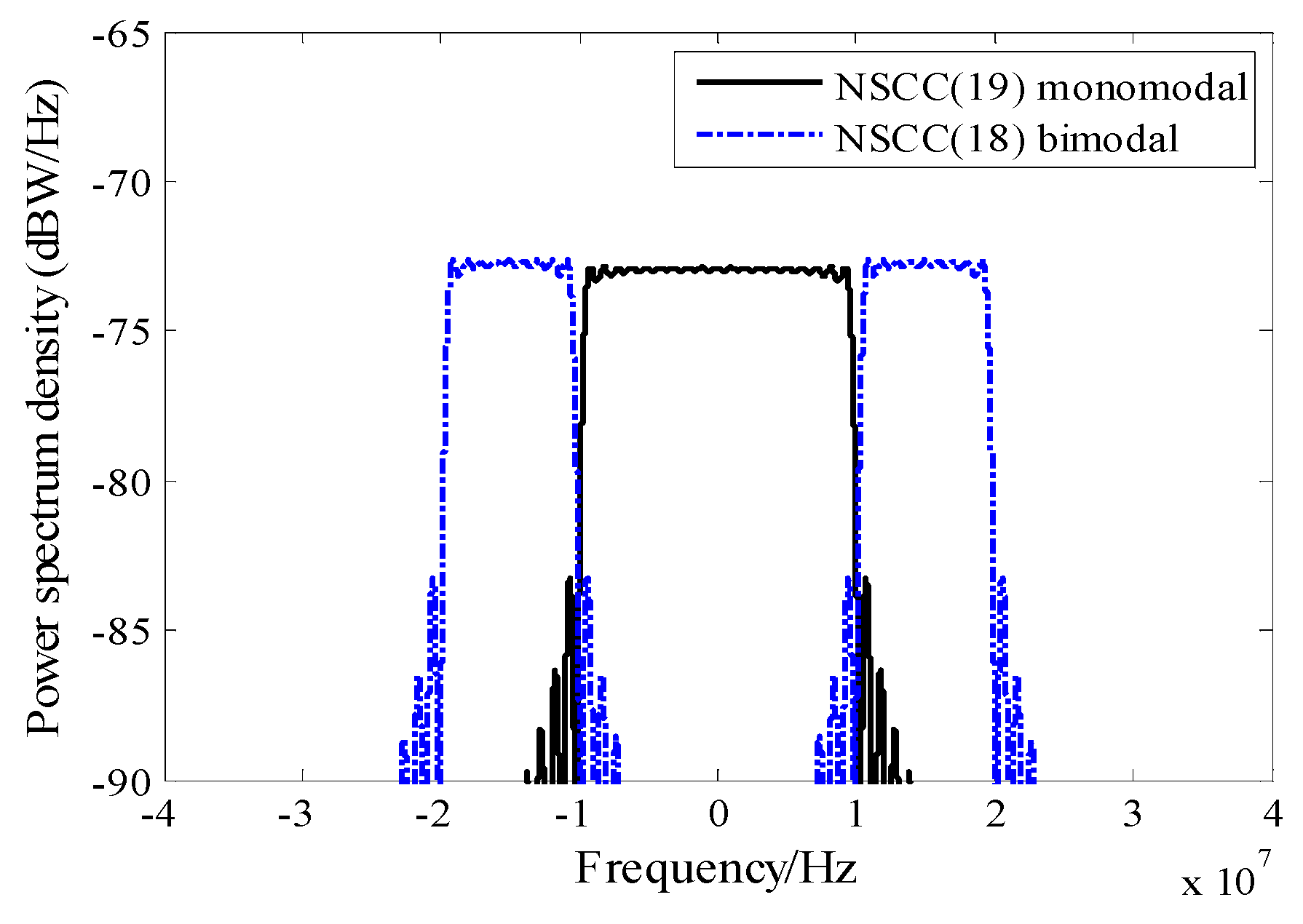
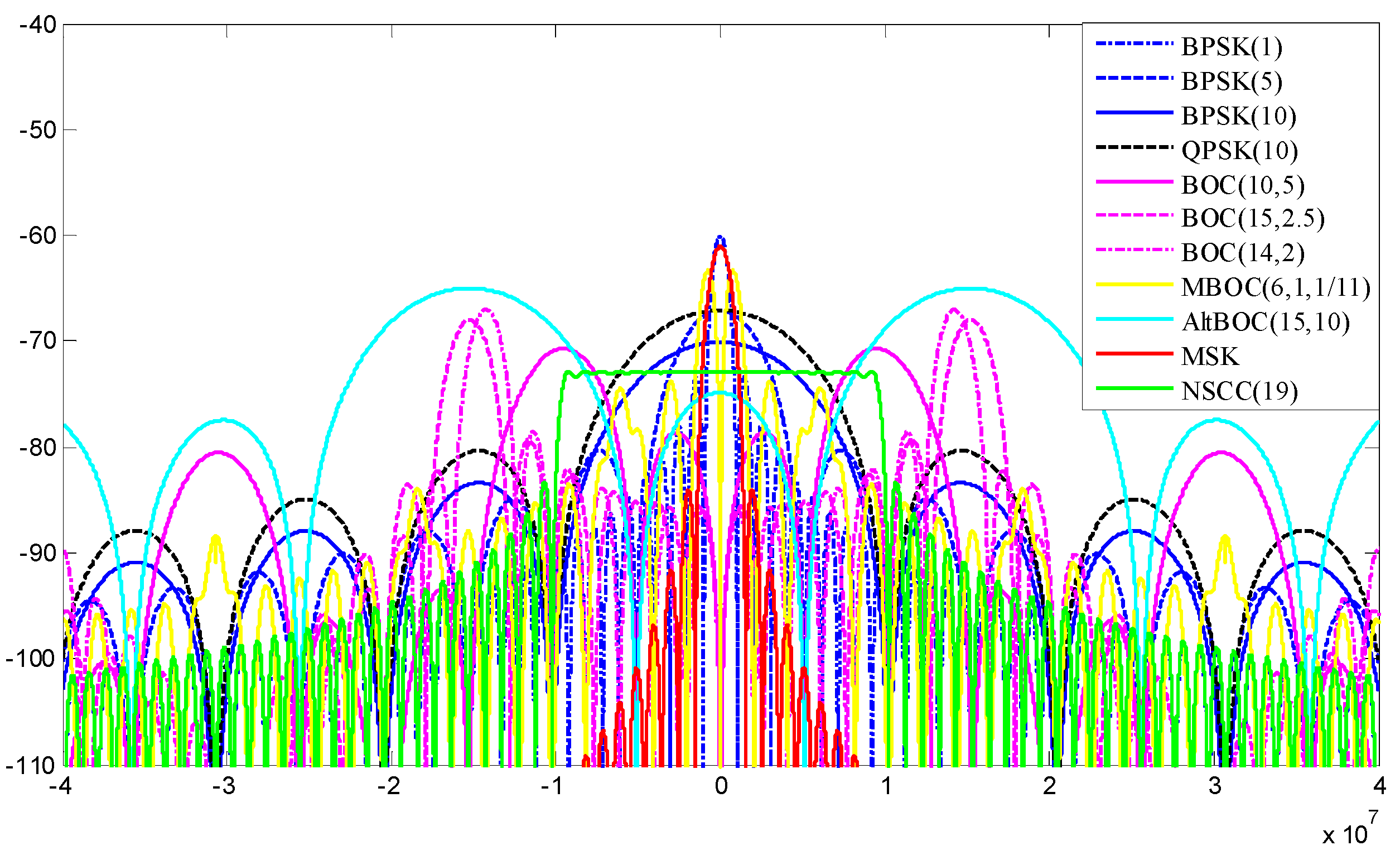
| Modulation Scheme | Main Lobe (dBW/Hz) | First Side Lobe (dBW/Hz) | Power Attenuation (dBW/Hz) |
|---|---|---|---|
| BPSK(1) | −60.10 | −73.36 | 13.26 |
| BPSK(5) | −67.09 | −80.35 | 13.26 |
| BPSK(10) | −70.10 | −83.36 | 13.26 |
| QPSK(10) | −67.09 | −80.35 | 13.26 |
| BOC(10,5) | −70.07 | −78.64 | 7.94 |
| BOC(15,2.5) | −67.96 | −79.32 | 11.36 |
| BOC(14,2) | −67.00 | −78.61 | 11.61 |
| BOC(6,1,1/11) | −63.31 | −73.87 | 10.56 |
| AltBOC(15,10) | −64.99 | −74.87 | 9.88 |
| MSK | −61.01 | −84.01 | 23.00 |
| NSCC | −70.10 | −82.05 | 12.04 |


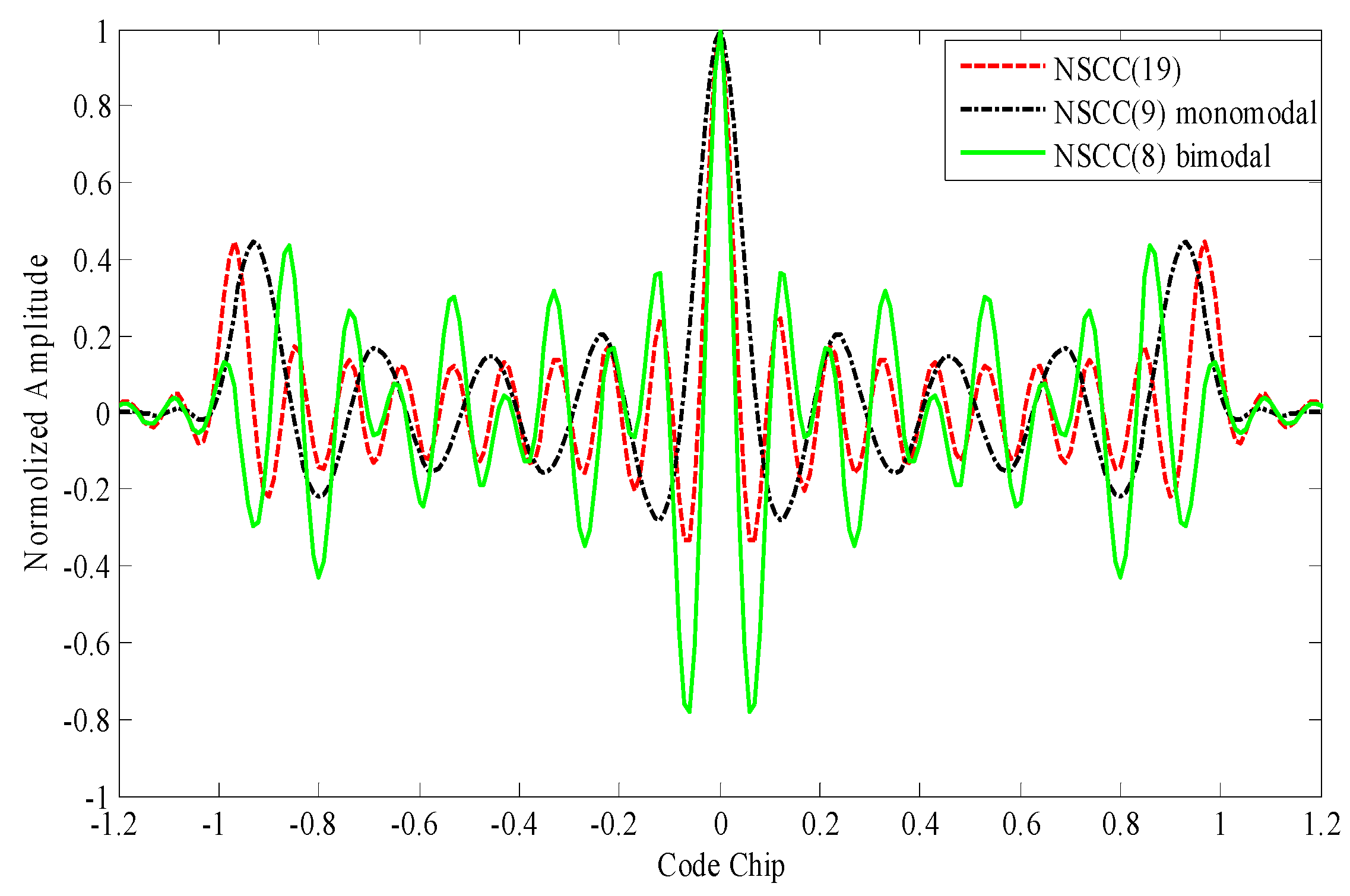
3. Evaluation Criteria
3.1. Spectral Separation Coefficient
3.2. Tracking Performance
3.3. Anti-Jamming Capability
3.4. Multipath Error Envelope
4. Evaluation and Analysis of NSCC with Representative Parameters
4.1. Spectral Separation Coefficient
| SSCs(dB) | C/A | MSK | BOC(1,1) | MBOC(6,1,1/11) | QPSK(10) | P | NSCCself |
|---|---|---|---|---|---|---|---|
| C/A | −61.9 | ||||||
| MSK | −62.3 | −62.4 | |||||
| BOC(1,1) | −67.9 | −66.3 | −64.9 | ||||
| MBOC(6,1,1/11) | −68.3 | −66.7 | −65.3 | −65.7 | |||
| QPSK(10) | −67.2 | −67.1 | −67.5 | −67.9 | −65.9 | ||
| P | −70.2 | −70.1 | −70.6 | −70.9 | −68.9 | −71.9 | |
| NSCC(19) | −73.0 | −72.9 | −73.1 | −73.1 | −70.4 | −73.4 | −73.1 |
| NSCC(9) | −72.9 | −72.7 | −73.1 | −73.5 | −71.2 | −74.2 | −73.0 |
| NSCC(4) | −72.6 | −72.5 | −73.1 | −73.5 | −73.5 | −76.5 | −72.9 |
| NSCC(3) | −72.5 | −71.9 | −73.0 | −73.4 | −74.5 | −77.5 | −72.7 |
| NSCC Mono | −69.8 | −69.7 | −70.1 | −70.5 | −68.2 | −71.2 | −70.0 |
| NSCC Bimo | −87.0 | −89.9 | −84.3 | −79.6 | −75.7 | −78.7 | −69.8 |
4.2. Tracking Performance
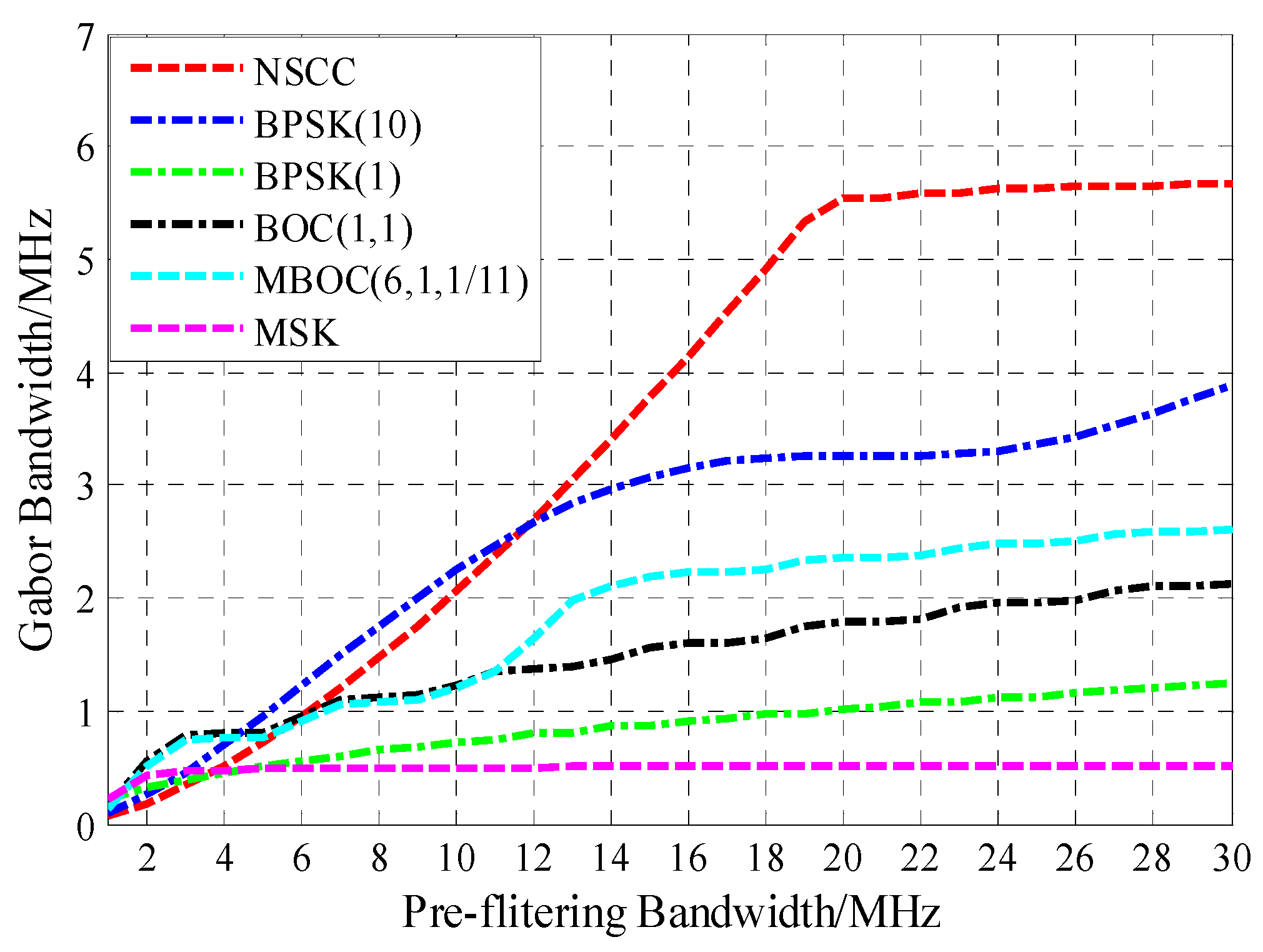
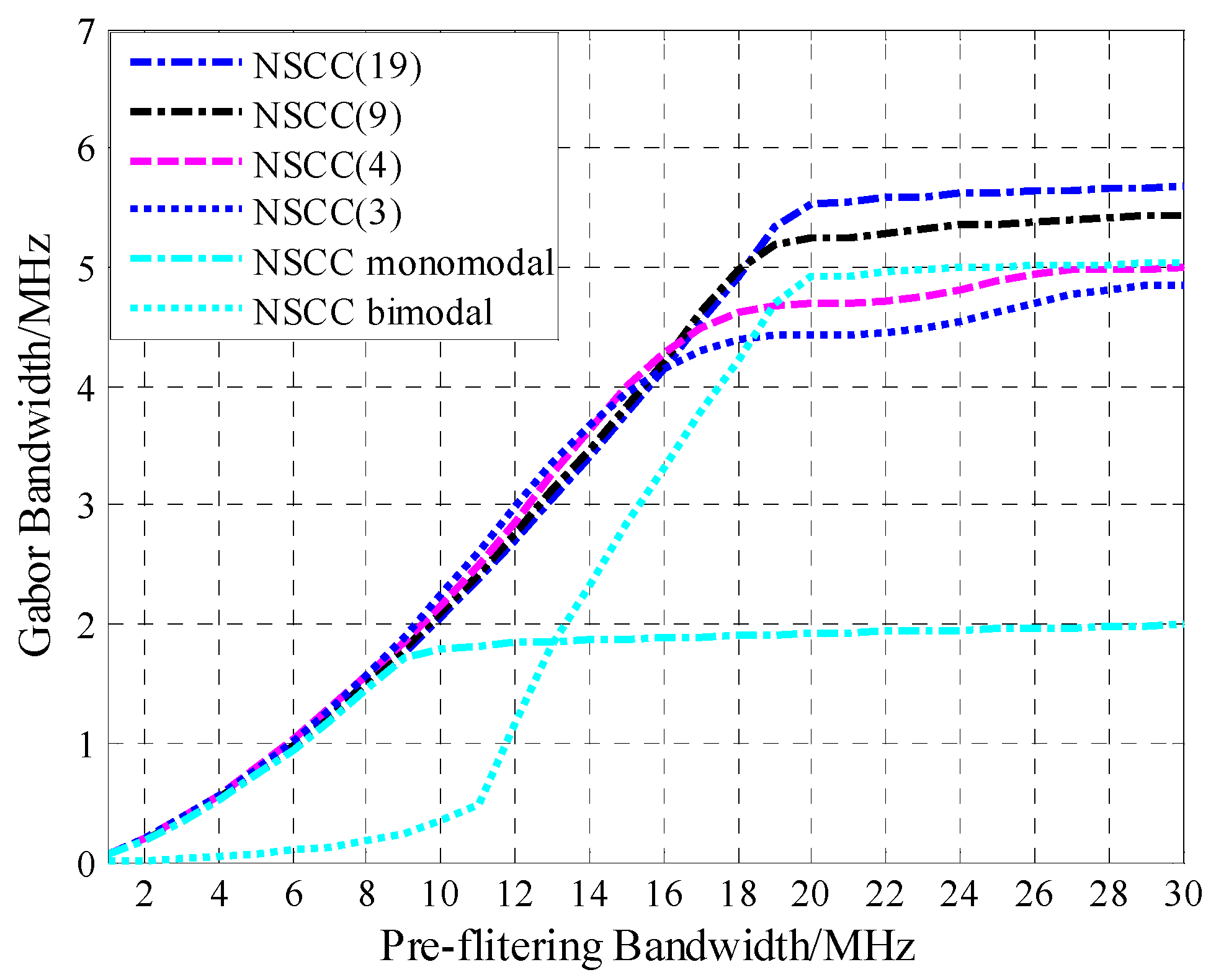
4.3. Anti-Jamming Capability

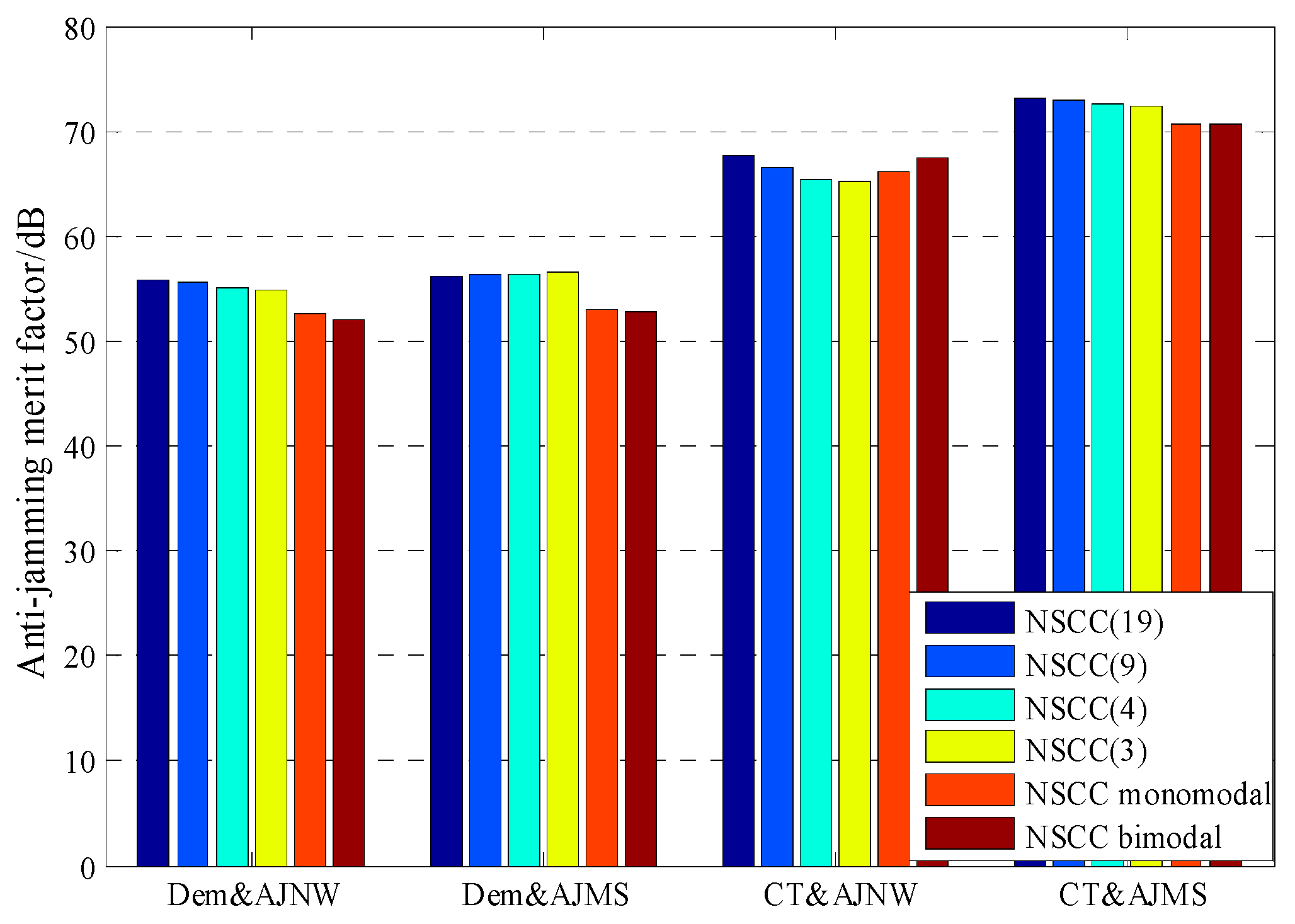
4.4. Multipath Error Envelop
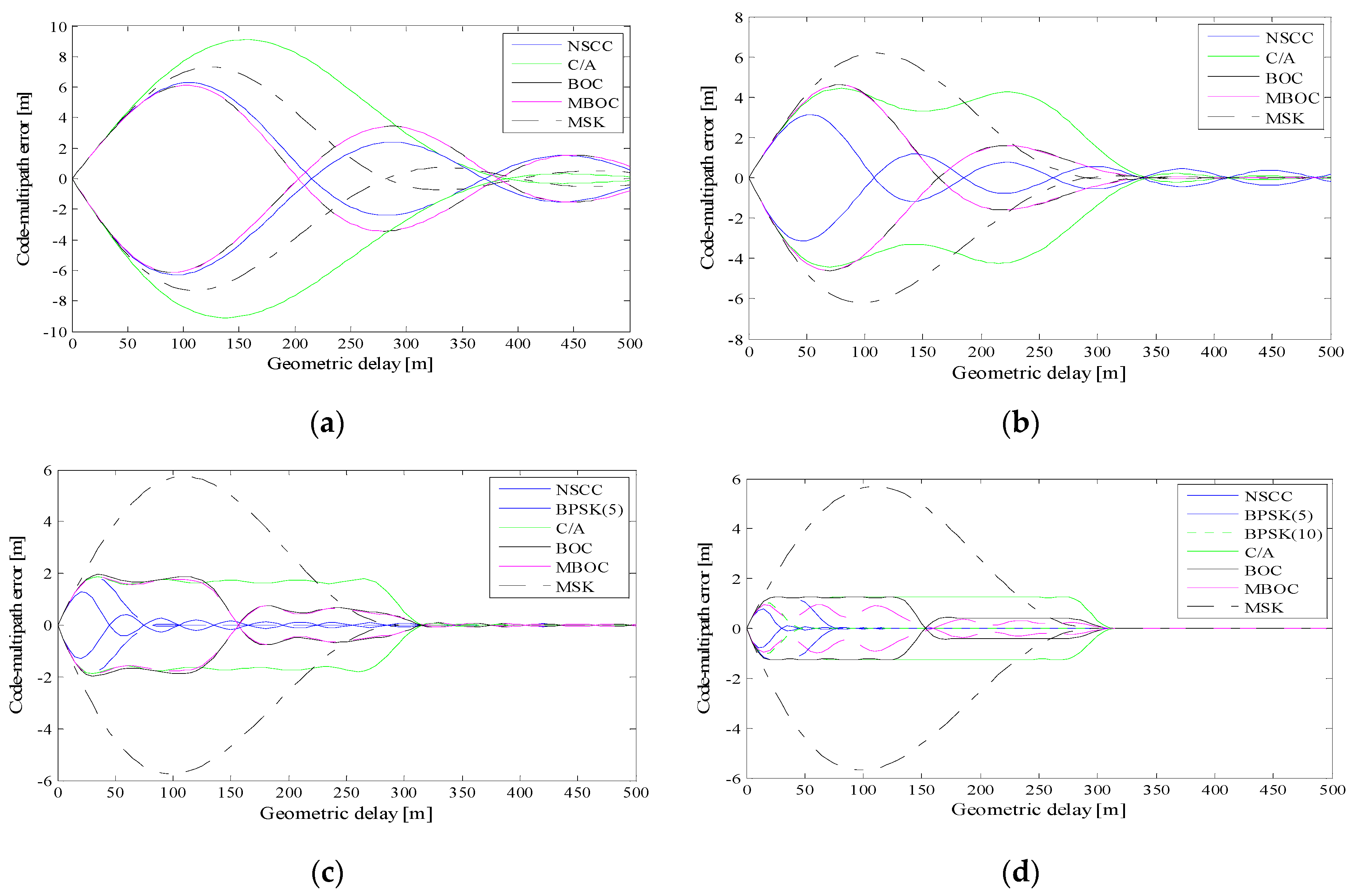
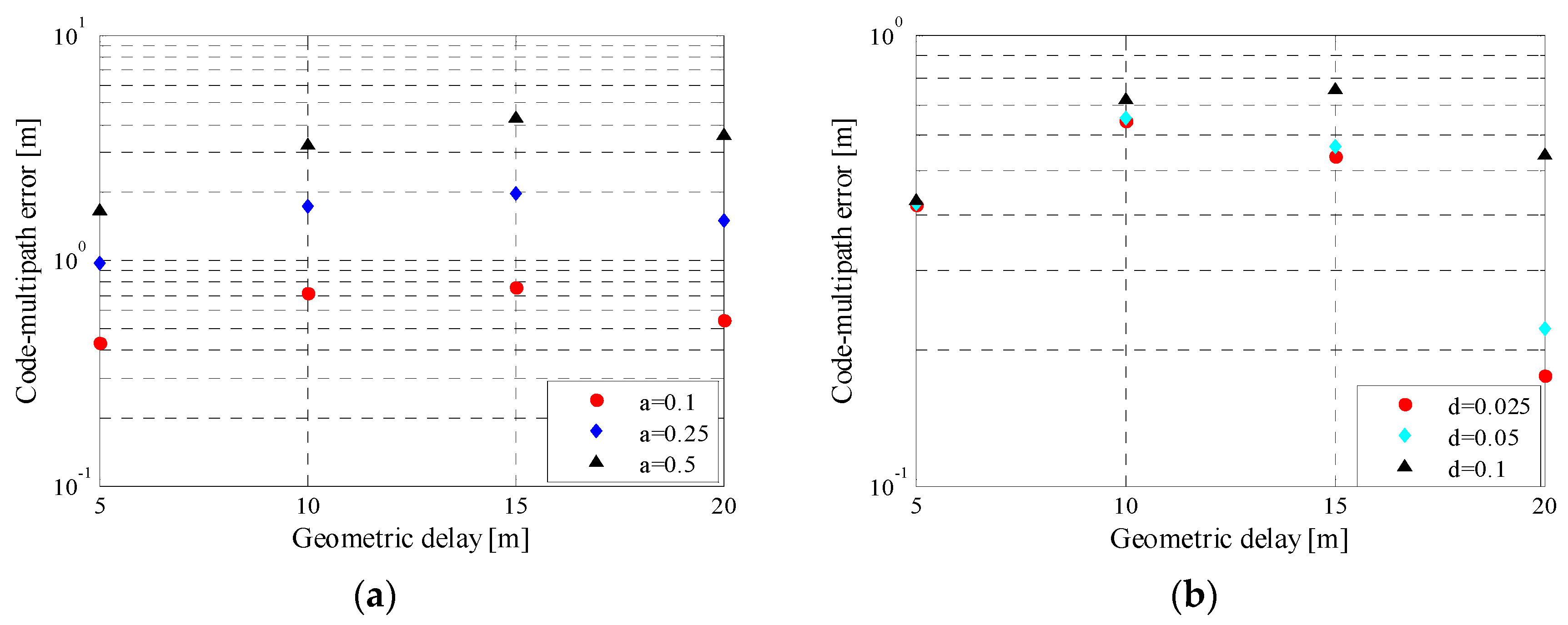
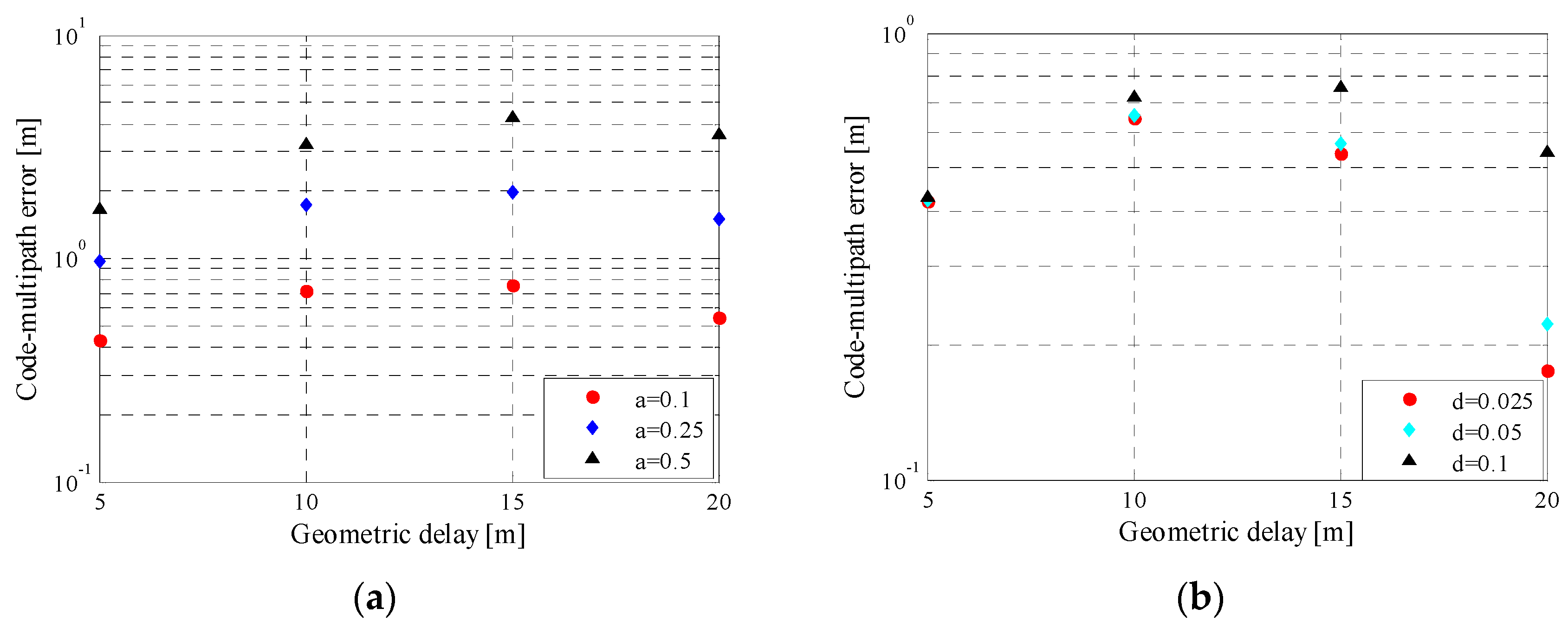
5. Conclusions
Acknowledgments
Author Contributions
Conflicts of Interest
References
- Shivaramaiah, N.C.; Dempster, A.G.; Rizos, C. Time-multiplexed offset-carrier QPSK for GNSS. IEEE Trans. Aerosp. Electron. Syst. 2013, 49, 1119–1138. [Google Scholar] [CrossRef]
- Betz, J.W. Signal structures for satellite-based navigation: Past, present, and future. In Proceedings of Institute of Navigation (ION) Pacific (PNT) 2013, Honolulu, HI, USA, 22–25 April 2013; pp. 131–137.
- Kaplan, E.; Hegarty, C. Understanding GPS: Principles and Applications; Artech house: Norwood, MA, USA, 2005. [Google Scholar]
- Betz, J.W. The offset carrier modulation for GPS modernization. In Proceedings of the 1999 National Technical Meeting of The Institute of Navigation, San Diego, CA, USA, 25–27 January 1999; pp. 639–648.
- Rebeyrol, E.; Macabiau, C.; Lestarquit, L.; Ries, L.; Issler, J.; Boucheret, M.; Bousquet, M. BOC power spectrum densities. In Proceedings of the 2005 National Technical Meeting of the Institute of Navigation (ION NTM), San Diego, CA, USA, 24–26 January 2005; pp. 769–778.
- Julien, O.; Macabiau, C.; Cannon, M.E.; Lachapelle, G. ASPeCT: Unambiguous sine-BOC (n, n) acquisition/tracking technique for navigation applications. IEEE Trans. Aerosp. Electron. Syst. 2007, 43, 150–162. [Google Scholar] [CrossRef]
- Xue, R.; Sun, Y.; Zhao, D. CPM Signals for Satellite Navigation in the S and C Bands. Sensors 2015, 15, 13184–13200. [Google Scholar] [CrossRef] [PubMed]
- Rodríguez, J.Á.Á. On Generalized Signal Waveforms for Satellite Navigation. Ph.D. Thesis, Universitätsbibliothek der Universität der Bundeswehr München, Munich, Germany, June 2008. [Google Scholar]
- Pratt, A.R.; Owen, J.I.R. Performance of GPS/Galileo receivers using m-PSK BOC signals. In Proceedings of the 2004 National Technical Meeting of the Institute of Navigation, San Diego, CA, USA, 26–28 January 2001; pp. 362–370.
- Dahlman, E.; Parkvall, S.; Skold, J. 4G: LTE/LTE-Advanced for Nobile Broadband; Academic Press: Cambridge, MA, USA, 2013. [Google Scholar]
- Palmer, J.E.; Harms, H.A.; Searle, S.J.; Davis, L.M. DVB-T passive radar signal processing. IEEE Trans. Sign. Proc. 2013, 61, 2116–2126. [Google Scholar] [CrossRef]
- Serant, D.; Thevenon, P.; Boucheret, M.L.; Julien, O.; Macabiau, C.; Corazza, S.; Dervin, M.; Ries, L. Development and validation of an OFDM/DVB-T sensor for positioning. In Proceedings of the IEEE Position Location and Navigation Symposium (PLANS), Indian Wells, CA, USA, 4–6 May 2010; pp. 988–1001.
- Serant, D.; Julien, O.; Thevenon, P.; Ries, L.; Dervin, M. Testing OFDM-based positioning using the digital TV signals. In Proceedings of the 20th IEEE European Signal Processing Conference (EUSIPCO), Bucharest, Romania, 27–31 August 2012; pp. 539–543.
- Garcia-Pena, A.; Julien, O.; Macabiau, C.; Won, J.-H.; Fontanella, D.; Paonni, M.; Eissfeller, B.; Emmanuele, A.; Luise, M.; Zanier, F. FMT signal options and associated receiver architectures for GNSS. In Proceedings of the 2012 IEEE/ION Position Location and Navigation Symposium (PLANS), Myrtle Beach, SC, USA, 23–26 April 2012; pp. 898–912.
- Emmanuele, A.; Luise, M.; Won, J.; Fontanella, D.; Paonni, M.; Eissfeller, B.; Zanier, F.; Lopez-Risueno, G. Evaluation of filtered multitone (FMT) technology for future satellite navigation use. In Proceedings of the 24th International Technical Meeting of the Satellite Division of the Institute of Navigation (ION GNSS 2011), Portland, OR, USA, 20–23 September 2011; pp. 3743–3755.
- Liu, X.; Liang, M.; Morton, Y.; Closas, P.; Zhang, T.; Hong, Z. Performance evaluation of MSK and OFDM modulations for future GNSS signals. GPS Solut. 2014, 18, 163–175. [Google Scholar] [CrossRef]
- Diez, J.; De Castro, D.; Palomo, J.M.; Tossaint, M. Integrated navigation and communication system based on OFDM. In Proceedings of the 2010 5th IEEE ESA Workshop on Satellite Navigation Technologies and European Workshop on GNSS Signals and Signal Processing (NAVITEC), Noordwijk, The Netherland, 8–10 December 2010; pp. 1–5.
- Deng, Z.; Yu, Y.; Yuan, X.; Wan, N.; Yang, L. Situation and development tendency of indoor positioning. Commun. China 2013, 10, 42–55. [Google Scholar] [CrossRef]
- Jeong, S.Y.; Jo, H.G.; Kang, S.J. Self-Organizing Distributed Architecture Supporting Dynamic Space Expanding and Reducing in Indoor LBS Environment. Sensors 2015, 15, 12156–12179. [Google Scholar] [CrossRef] [PubMed]
- Galeana-Zapién, H.; Torres-Huitzil, C.; Rubio-Loyola, J. Mobile Phone Middleware Architecture for Energy and Context Awareness in Location-Based Services. Sensors 2014, 14, 23673–23696. [Google Scholar] [CrossRef] [PubMed]
- Xu, Y.; Yuan, H. Navigation signal structure based on complex carrier modulation. Sci. China Phys. Mech. Astron. 2011, 54, 1035–1045. [Google Scholar] [CrossRef]
- Sohn, I. A Low Complexity PAPR Reduction Scheme for OFDM Systems via Neural Networks. IEEE Commun. Lett. 2014, 18, 225–228. [Google Scholar] [CrossRef]
- Sabbaghian, M.; Kwak, Y.; Smida, B.; Tarokh, V. Near Shannon limit and low peak to average power ratio turbo block coded OFDM. IEEE Trans. Commun. 2011, 59, 2042–2045. [Google Scholar] [CrossRef]
- Luo, R.; Xu, Y.; Yuan, H. A Joint acquisition method for navigation signal based on compound carrier with CAFR. Acta Aeronautica et Astronautica Sinica 2015, 36, 2381–2391. (In Chinese) [Google Scholar]
- Luo, R.; Xu, Y.; Yuan, H. Acquisition for navigation signal with complex carrier modulation based on co-herent superposition. J. Astronnaut. 2015, 36, 961–968. (In Chinese) [Google Scholar]
- Fine, P.; Wilson, W. Tracking algorithm for GPS offset carrier signals. In Proceedings of the 1999 National Technical Meeting of The Institute of Navigation, San Diego, CA, USA, 25–27 January 1999; pp. 671–676.
- Wallner, S.; Hein, G.W.; Pany, T.; Avila-Rodriguez, J.; Posfay, A. Interference computations between GPS and Galileo. In Proceedings of the ION-GNSS, Long Beach, CA, USA, 13–16 September 2005.
- Betz, J.W.; Goldstein, D.B.; Bedford MA, M.C. Candidate Designs for an Additional Civil Signal in GPS Spectral Bands; Ft. Belvoir Defense Technical Information Center: Fort Belvoir, VA, USA, 2002. [Google Scholar]
- Hegarty, C.; Betz, J.W.; Saidi, A. Binary coded symbol modulations for GNSS. In Proceedings of the 60th Annual Meeting of the Institute of Navigation, Dayton, OH, USA, 7–9 June 2004; pp. 56–64.
- Avila-Rodriguez, J.A.; Pany, T.; Hein, G.W. Bounds on signal performance regarding multipath-estimating discriminators. In Proceedings of the 2006 ION-GNSS, Fort Worth, TX, USA, 26–29 September 2006.
- Balaei, A.T.; Barnes, J.; Dempster, A.G. Characterization of interference effects on GPS signal carrier phase error. In Proceedings of the 2005 Spatial Intelligence, Innovation and Praxis: The National Biennial Conference of the Spatial Science Institute (SSC), Melbourne, Australia, 12–16 September 2005.
- Betz, J.W. Effect of narrowband interference on GPS code tracking accuracy. In Proceedings of the 2000 National Technical Meeting of The Institute of Navigation, Anaheim, CA, USA, 26–28 January 2000; pp. 16–27.
- Tang, Z.; Zhou, H.; Hu, X.E.A.; Ran, Y.; Liu, Y.; Zhou, Y. Research on performance evaluation of compass signal. Sci. China Phys. Mech. Astron. 2010, 40, 592–602. (In Chinese) [Google Scholar]
- Hein, G.W.; Avila-Rodriguez, J.A.; Wallner, S.; Pratt, A.R.; Owen, J.; Issler, J.L.; Betz, J.W.; Hegarty, C.J.; Lenahan, L.S. MBOC: The new optimized spreading modulation recommended for GALILEO L1 OS and GPS L1C. In Proceedings of the IEEE/ION PLANS, San Diego, CA, USA, 25–27 April 2006; pp. 884–892.
- Irsigler, M.; Avila-Rodriguez, J.A.; Hein, G.W. Criteria for GNSS multipath performance assessment. In Proceedings of the 2005 ION GNSS, Long Beach, CA, USA, 13–16 September 2005.
© 2016 by the authors; licensee MDPI, Basel, Switzerland. This article is an open access article distributed under the terms and conditions of the Creative Commons by Attribution (CC-BY) license (http://creativecommons.org/licenses/by/4.0/).
Share and Cite
Luo, R.; Xu, Y.; Yuan, H. Performance Evaluation of the New Compound-Carrier-Modulated Signal for Future Navigation Signals. Sensors 2016, 16, 142. https://doi.org/10.3390/s16020142
Luo R, Xu Y, Yuan H. Performance Evaluation of the New Compound-Carrier-Modulated Signal for Future Navigation Signals. Sensors. 2016; 16(2):142. https://doi.org/10.3390/s16020142
Chicago/Turabian StyleLuo, Ruidan, Ying Xu, and Hong Yuan. 2016. "Performance Evaluation of the New Compound-Carrier-Modulated Signal for Future Navigation Signals" Sensors 16, no. 2: 142. https://doi.org/10.3390/s16020142






